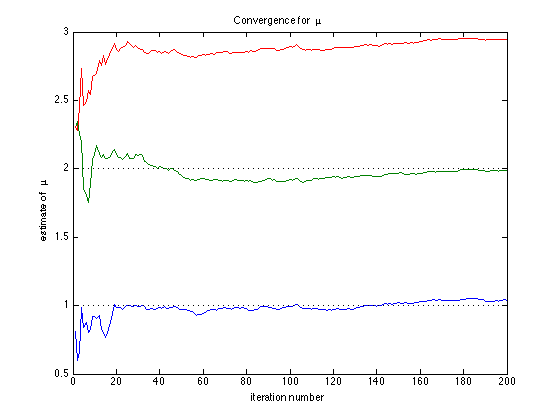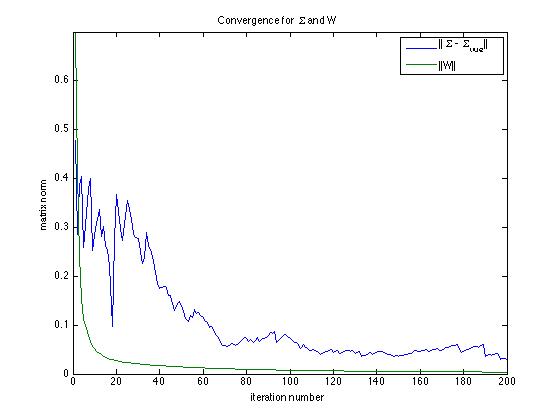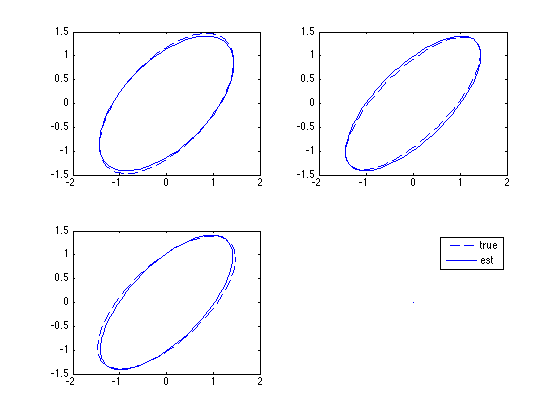EPPES example using linear model
This example demonstrates the ability of EPPES method to find the known true distribution in case of linear model.
We assume that observations are generated sequentially from y~N(theta,Sigma_{obs}) where the mean theta will be random, i.e. at each observation time window the value of theta is drawn from a hyper distribution theta~N(mu,Sigma). The parameters mu and Sigma are then estimated sequentially.
Laine, et al.: Ensemble prediction and parameter estimation system: the method, Q. J. R. Meteorol. Soc., 2011, doi:10.1002/qj.922.
npar = 3; % number of unknown parameters
True Sigma and mu.
trueSigma = covcond(10,ones(npar,1)) * 0.8
truemu = (1:npar)'
R = chol(trueSigma); % Cholesky factor of Sigma for random number generator
trueSigma =
0.34182 0.2102 0.24799
0.2102 0.36071 0.22909
0.24799 0.22909 0.32292
truemu =
1
2
3
Error std in observations.
sigeps = 0.8;
Initial guess/prior for mu and its accuracy.
mu = zeros(npar,1); W = eye(npar)*2^2;
Initial Sigma and its weight n.
Sig = eye(npar)*1.^2; % this has to be big enough n = 1; % how well we know Sig
nens = 51; % ensemble size nobs = 10; % n:o of observations in one stage nsimu = 200; % number of simulation stages
muall = zeros(nsimu,npar); signorm = zeros(nsimu,1); Wnorm = zeros(nsimu,1);
for isimu=1:nsimu theta = mvnorr(1,truemu,trueSigma,R)'; % sample one theta from the true dist % we directly observe theta with error sigeps thetaobs = mvnorr(nobs,theta,eye(npar).*sigeps.^2); % posterior for theta when prior is prior N(mu,Sigma) Sigpost = inv(eye(npar)./sigeps.^2.*nobs+inv(Sig)); mupost = Sigpost*(mean(thetaobs,1)'./sigeps.^2.*nobs+inv(Sig)*mu); % ensemble is drawn directly from the posterior thetaens = mvnorr(nens,mupost,Sigpost); % update hyper parameters according to the ensemble [mu,W,n,Sig] = eppesupd(thetaens,mu,W,n,Sig); % save muall(isimu,:) = mu'; signorm(isimu) = norm(Sig-trueSigma); Wnorm(isimu) = norm(W); end
Now, mu should converge to truemu, Sig to trueSigma, W to zeros.
mu, Sig, W
mu =
1.0402
1.9858
2.9456
Sig =
0.34458 0.20097 0.2418
0.20097 0.33381 0.2306
0.2418 0.2306 0.33317
W =
0.0017204 0.00093795 0.0012181
0.00093795 0.0015914 0.0010834
0.0012181 0.0010834 0.001753
The first figure shows the convergence on mu to the true values given as horizontal lines.
figure(1); clf plot(1:nsimu,muall) for i=1:npar,hline(truemu(i));end xlabel('iteration number'); ylabel('estimate of \mu') title('Convergence for \mu ')

In the second figure, the norms of matrix W and difference Sigma-trueSigma are plotted with the iteration number.
figure(2); clf plot(1:nsimu,signorm,1:nsimu,Wnorm) title('Convergence for \Sigma and W') xlabel('iteration number'); ylabel('matrix norm') legend('||\Sigma - \Sigma_{true}||', '||W||') ylim([0,0.7])

The last figure shows pair-wise 95% probability ellipsoids of the estimated Sigma and trueSigma at the last time window.
figure(3); clf subplot(2,2,1); ii=[1,2]; ellipse([0,0],trueSigma(ii,ii)*6,'--') hold on ellipse([0,0],Sig(ii,ii)*6,'-') hold off subplot(2,2,2); ii=[1,3]; ellipse([0,0],trueSigma(ii,ii)*6,'--') hold on ellipse([0,0],Sig(ii,ii)*6,'-') hold off subplot(2,2,3); ii=[2,3]; ellipse([0,0],trueSigma(ii,ii)*6,'--') hold on ellipse([0,0],Sig(ii,ii)*6,'-') hold off subplot(2,2,4); plot(0,0,'--',0,0,'-b') legend('true','est') axis off
